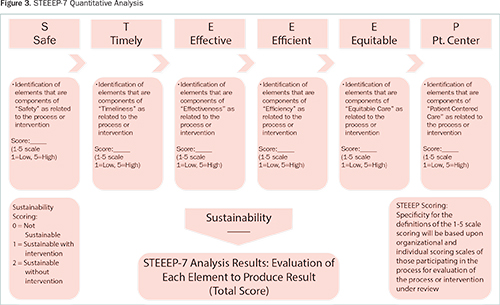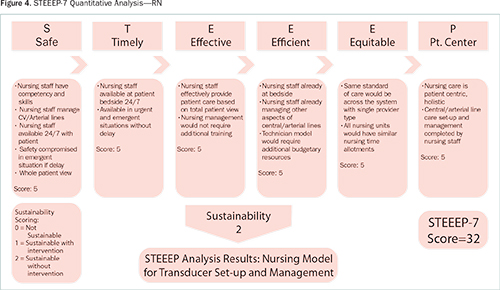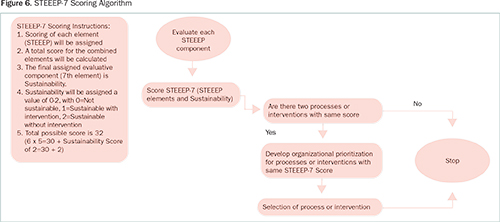Improvement Interventions and the IOM Aims for Quality: STEEP-7
Quantitative STEEEP-7 analysis
After developing and using the qualitative STEEEP analysis, it was determined that there should be a method for discriminating quantitatively among multiple interventions for the same identified gap or improvement project. That led to the development of the STEEEP-7 tool. STEEEP-7 uses all of the aspects of the STEEEP qualitative tool and adds numeric quantification and scoring for each of the elements. Figure 3 provides the scoring for the quantification of the STEEEP-7 analysis.

The notable difference is the scoring and the addition of a seventh element: sustainability. Sustainability of the intervention was found to be a deciding factor in the transducer example. Over time, the role of the anesthesia technician may change over time; however, the more definitive argument for the RN model was that it was independently sustainable, while the anesthesia technician model would require additional resources to implement and sustain.
To illustrate the added benefits of the quantitative evaluation of the STEEEP-7, the RN and anesthesia technician models were scored using the process and are provided in Figures 4 and 5.
The quantitative analysis of the STEEEP-7 allows improvement teams to effectively determine a numerical difference between interventions. Although the rating scale may be subjective, it provides the most objective-subjective determination possible, similar to the FMEA scoring process.


Scoring for the STEEEP-7
The scoring for the STEEEP-7 is simply a 5-point, 1-to-5 scale in which each element is individually scored, with 1 being the lowest and 5 being the highest score for each element. For example, if an intervention is believed to provide the highest level of timely care, then the element would be scored as a 5. The scale’s points are not specifically defined; the definitions are left to the individual or organization. The sustainability score is based on a 3-point scoring model, with 0 points for an intervention that is not sustainable, 1 point for an intervention that is sustainable with additional intervention, and 2 points for an intervention that is sustainable without additional intervention.
An algorithm was developed to assist in the scoring of the STEEEP-7, as shown in Figure 6. There is a total possible score of 32 points for the STEEEP-7 analysis. Using this method, improvement interventions are scored, with the highest score determining the best intervention based on comparison to the IOM quality aims. In the case of interventions that tie in scoring, an organization may prioritize the interventions based on its own operational model.

Safety score considerations for the model
Because patient safety is the highest necessity, the safety score for the model requires additional discussion. An intervention could feasibly be scored lower on safety and, from a numerical perspective, still be the “highest” scored intervention. For the purposes of this model, 1—the lowest score—is defined as “safe to implement the intervention or process.” At the time of the scoring, the users may not be aware of all the latent factors that may impact an intervention, and its safe implementation may be dependent on outside factors; however, in order to implement the intervention, there has to be a level of safety that the organization would deem appropriate. The developers of the STEEEP-7 tool would never seek to promote low safety in developing an intervention; therefore, this particular element of the tool requires definition outside of the five other elements.
